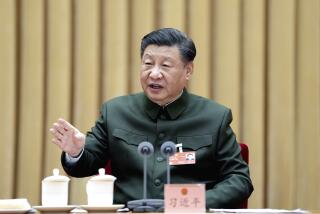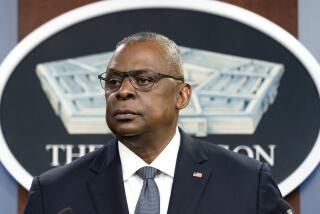Obama won’t rush on Afghanistan decisions
WASHINGTON — On a day when his administration outlined ambitious goals for Afghanistan and Pakistan, President Obama also moved Wednesday to call a timeout in the escalating national debate over a possible troop increase in Afghanistan.
Obama insisted he would not be rushed in deciding whether to send more troops -- an action favored by top military leaders but questioned by a growing number of Democrats -- saying that additional time is needed to refine strategy and assess needs.
Yet the lofty goals set by the White House -- such as promoting an Afghan government that can combat extremism and corruption while supporting human rights -- represent difficult, time-consuming work likely to require additional military and nonmilitary commitments at a time of flagging support from Obama’s wary political base.
The U.S. troop level is already due to rise to 68,000 this year, and the prospect of sending more personnel has triggered a backlash among leading congressional Democrats. Many Republicans, meanwhile, have sided with military commanders in urging Obama to send additional troops.
Obama sought Wednesday to cool that debate, staking out a middle position in an appearance with Canadian Prime Minister Stephen Harper, who is planning to withdraw his nation’s 2,500 troops in 2011. Obama said he was not going to decide whether to escalate until he had “the strategy right.”
“You don’t make determinations about resources, and certainly you don’t make determinations about sending young men and women into battle, without having absolute clarity about what the strategy is going to be,” Obama said.
But as the administration outlined its goals and ways of measuring progress in the troubled region Wednesday, some lawmakers complained that the yardsticks were too general or vague.
Objectives include disrupting terrorist networks in Afghanistan and Pakistan; improving Pakistan’s ability to battle insurgents; expanding Afghan forces and defeating the insurgency in Afghanistan; and upgrading the Afghan government, including its judiciary and support for human rights.
The goals are based on a strategy announced by the Obama administration in March. Since then, there have been few details from the Pentagon or State Department about how the U.S. government would put that strategy into action.
But the objectives as well as the “metrics” to measure them go well beyond the stated goal of defeating Al Qaeda in both Pakistan and Afghanistan. Yardsticks for progress in the two nations focus at least as much on rooting out the Taliban and on the nations’ having resilient, reliable and friendly governments.
Army Gen. Stanley A. McChrystal, who took over this year as commander of allied forces in Afghanistan, has been working on a more detailed strategic plan and is developing a request for more resources.
An assessment last month by McChrystal, which was described to lawmakers for the first time Wednesday, represented the first step in refining the strategy and making the case for a larger troop presence.
The National Security Council plans to complete its first progress report by December, and Congress wants to see the report a few months later. However, McChrystal is likely to want troop decisions well in advance of the winter months.
But first, Obama wants an assessment of civilian and diplomatic efforts, akin to the military assessment recently completed by McChrystal.
“My determination is to get this right,” Obama said. “And I am going to take a very deliberate process in making these decisions.”
Lawmakers have pressed the White House to establish measurements for progress in Afghanistan comparable to the benchmarks that had been established for Iraq.
The Iraq benchmarks set goals to examine political progress and security improvements, but they were largely set aside by the Bush administration as violence there eased in late 2007.
In Afghanistan, which has seen sharp increases in the number of insurgent attacks on American and NATO forces, military officials have said a turnaround is not likely to be as quick as in Iraq.
As well, a senior administration official, who described the development of the objectives on condition of anonymity, said the metrics created for Afghanistan and Pakistan differ markedly from the Iraq benchmarks.
In Iraq, Congress set concrete objectives, such as movement of troops into Baghdad and passage of key pieces of legislation. The Afghanistan and Pakistan metrics are more general, such as progress toward stable governments or steps to combat corruption.
The administration official said the White House discarded metrics that entailed resources put into the war, such as the number of Afghan security forces trained, in favor of measuring results, like effectiveness of those forces in conducting counterinsurgency missions.
The senior administration official acknowledged that there are inherent problems in asking agencies in charge of the war effort to measure their own progress.
To improve the process, the director of national intelligence has been asked to establish a “red team” of outside experts to independently measure progress and double-check official assessments.
Nonetheless, the nature of the yardsticks is likely to provide critics with ammunition to argue that progress is coming too slowly and that achieving the broad objectives ultimately may not be possible.
“This isn’t cost-free. We may well have some communication challenges,” said the senior official. “But more important is holding ourselves accountable.”
--
More to Read
Sign up for Essential California
The most important California stories and recommendations in your inbox every morning.
You may occasionally receive promotional content from the Los Angeles Times.










